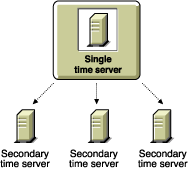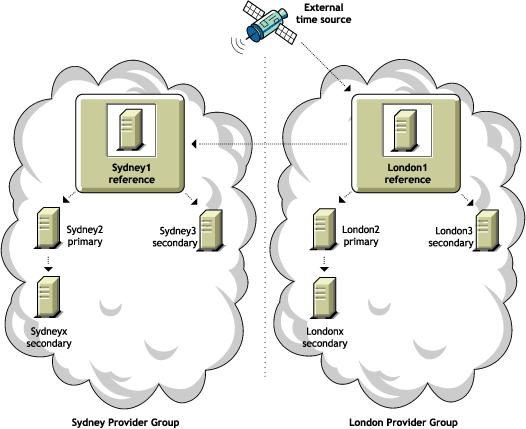1.2 Identifying Timesync Server Types
To use Timesync, you must configure the NetWare servers. Timesync configuration allows some servers to be time providers and other servers to follow the time providers and become time consumers. Time consumers can provide time to the workstations and other servers in the network.
The following are Timesync server types that you must use to configure Timesync.
NOTE:All Timesync servers can accept or provide time from and to NTP providers and consumers. There is a built-in NTP time consumer and NTP time provider in Timesync for this purpose. Timesync is not fully compliant with NTP.
For a quick reference on time server configuration, see Configuration Checklist for Time Servers.
1.2.1 Single Time Server
A Single time server provides time to Secondary servers and workstations.
A Single server can obtain time from a NTP time provider or from its own internal clock. This server acts as a master time provider to the Timesync network.
The Single time server falls back to the local clock if both of the following cases are true:
-
If the NTP time provider is not contactable
-
the Single time server has remained in synchronization with the NTP source for more than 10 minutes of polling delay
By default, the first server installed on a eDirectory tree is configured as a Single time server and other NetWare servers in the eDirectory tree are configured as Secondary time servers.
All other servers must be able to contact the Single time server to synchronize or change time on the network. The network administrator sets the time on the Single time server.
IMPORTANT:There can be only one Single time server in a eDirectory tree. There can be only one Single time server in a Timesync network.
The following figure illustrates a Single time server providing time to Secondary time servers. The Secondary time servers, in turn, provide time to their workstations.
Figure 1-3 A single time server providing time to secondary time servers

1.2.2 Reference Time Server
A Reference time server provides time to Primary and Secondary servers, including workstations.
A Reference time server can obtain time from an NTP time provider.
A Reference time server will fall back to its local clock if time sources are not configured. Otherwise, it will fall back to its local clock if any one of these conditions is true:
-
All its configured sources are not contactable
-
All its configured sources are not in sync
Reference time servers do not adjust their internal clocks; instead, the Primary time servers' internal clocks are adjusted to synchronize with the Reference time server. A Reference time server acts as a central point to set network time. At server startup, the hardware clock is set to the time obtained from its external time source.
More than one Reference time server can coexist in one Timesync network.
The following figure shows a Reference time server synchronized to an external clock. The Reference time server, in turn, provides time to its own secondary servers and workstations, as well as to the Reference time server at another location.
Figure 1-4 A reference time server synchronized to an external clock

1.2.3 Primary Time Server
A Primary time server synchronizes the time with a Reference time server or an external NTP source. These servers can provide time to Secondary time servers and workstations. Primary time servers are also designed to share time with other primary servers. Primary servers are used to vote (calculate a common offset) amongst each other and arrive at a common network time. Here, the time from Reference time server will have more weight age than the primaries.
Use the Primary time server on larger networks to increase fault tolerance by providing redundant paths for Secondary time servers. If a Primary time server goes down, the Secondary time server can get the time from an alternate Primary time server.
Primary server should have at least one primary and one reference time source to be synchronized properly. Otherwise, though the server is synchronized, it will be in suspected or non fault tolerant state.
The Primary time server falls back to the local clock if both of the following cases are true:
-
If the NTP time provider is not contactable
-
the Primary time server has remained in synchronization with the NTP source for more than 10 minutes of polling delay
1.2.4 Secondary Time Server
A Secondary time server obtains the time from a Single, Primary, or Reference time server. It provides time to other Secondary time servers and workstations on the network. It adjusts its internal clock to synchronize with the network time. It provides the time to workstations, but it does not participate in determining the correct network time.
If you designate a server on the network as a Single time server, designate all other servers on the network as a Secondary time servers.
If you designate several servers on the network as Primary or Reference time servers, designate all other servers on the network as Secondary time servers.
1.2.5 Configuration Checklist for Time Servers
The following table lists the time providers and time consumers that can be connected to each other.